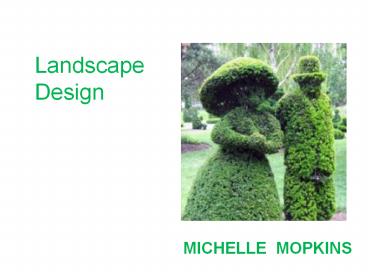Economic Value of Landscape design | Michelle Mopkins - PowerPoint PPT Presentation
Title:
Economic Value of Landscape design | Michelle Mopkins
Description:
Landscape design typically involves creative design and artifact, horticultural finesse and ability, and emphasis on detailed site involvement from visionary stages through to final construction. – PowerPoint PPT presentation
Number of Views:79
Title: Economic Value of Landscape design | Michelle Mopkins
1
Michelle mopkins
Landscape Design
2
Landscape Design
- The art of developing property for its greatest
use and enjoyment - Involves understanding the environment around the
structure and selecting plants that perform well
in that environment.
3
Economic Value
- Increase property value 6 to 15 percent
- Reduce energy costs
- Buffer wind
- Control solar heat gain
4
Functional Value
- Aesthetic value
- Enhance livability
- Conservation and environmental protection
- Solar heat control
- Wind control
- Sound control
- Slope stabilization
5
Environmental Effects
- Landscaping can
- Moderate temperatures
- Reduce glare and wind
- Use water more efficiently
- Clean the air
- Provide wildlife habitat
Bird and Butterfly habitat
6
Rules and Regulations
- State, local, and/or community regulations may
control landscape design. - Storm water drainage
- Tree ordinances
- Street trees
- Street yard
- Buffer yards
- Street wall
- Parking screen and islands
- Trash screen
7
Rules and Regulations
- Storm water regulations
8
Rules and Regulations
- Tree Ordinances
9
Rules and Regulations
- Street Trees
10
Rules and Regulations
- Street Yard
11
Rules and Regulations
- Buffer Yards
12
Rules and Regulations
- Parking Screens and Islands
13
Rules and Regulations
- Trash Screen
14
Principles of Design Concepts used to
organize the elements of a design
- Repetition
- Balance
- Emphasis
- Unity
15
Repetition
Principles of Design
- Use of the same element over and over
- Repetition is achieved when the same line, shape,
color, texture, plant, or material is used
throughout the landscape
16
Repetition
17
Balance
Principles of Design
- A sense of equality that can either be symmetric
or asymmetric.
Formal Balance A symmetrical design in which
the design can be divided into two identical
halves. Informal Balance An asymmetrical design
that can not be divided into identical halves but
that provides an overall sense of equilibrium.
18
Balance
Formal Balance
19
Emphasis
Principles of Design
- The result of focusing attention on one aspect of
a design. - Emphasis is constructed by creating a visual path
from at least one vantage point to the focal
point.
Focal Point The object of attention Vantage
Point The place from which the focal point is
viewed
20
Emphasis
21
Unity
Principles of Design
- The impression that the separate parts of the
design belong together or are part of a whole.
- Unity is created by
- A consistent style (Japanese, formal, etc.)
- Visual pathways
- Consistent color scheme
- Repetition of lines, plants, and hardscape
22
Unity
23
- THANK YOU































